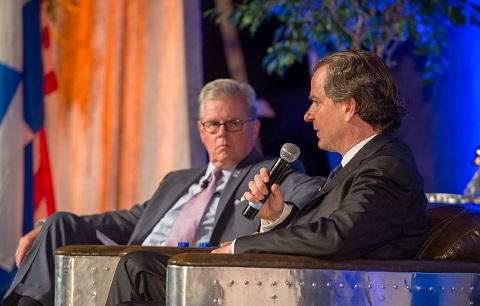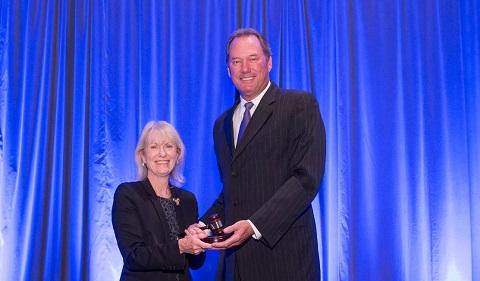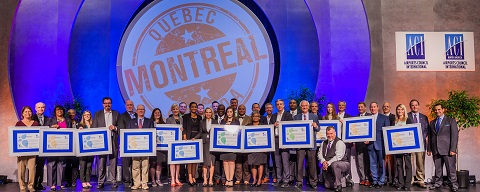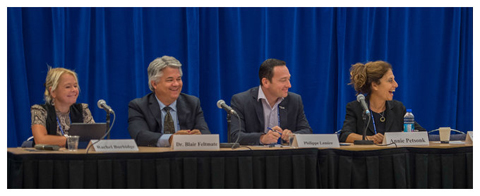![]() Print this Article | Send to Colleague
Print this Article | Send to Colleague

Crisis Communication: The World Is Watching
The impact a crisis can have on an airport was stamped into the eyes of everyone sitting in 517BC following the short CNN video that started off the Crisis Communication: The World Is Watching session that was held during General Session 1. It showed some of the initial coverage of these three catastrophic recent events:
>March 8, 2014: Missing airplane at Malaysian Airline
>May 5, 2016: Wildfires at Fort McMurray International Airport
>March 22, 2016: Two explosions at Brussels Airport
"We live in a world wracked with crises at all times," said James Cherry, pausing for impact as the attendees absorbed the reality of the horror in the videos. "And airports are never immune to these events that could have a major impact on our operations."
But, while there are different types of crises - ranging from floods to fires to bombs - they all have one thing in common: "They are unpredictable," said Cherry. Almost as unpredictable is the information posted on social media sites, such as Facebook and Twitter. "Almost everyone has a smartphone they can use to take a picture," said Cherry. "No filter." This causes confusion, especially in the beginning, in addition to giving every major crisis "a global dimension."
Communication, accurate communication, is an integral part of any crisis, however. "We know that crisis and communication go hand in hand," said Cherry.
Crises also require immediate action. "But, do you follow a plan or should you rely on your instincts?"
The leaders in this panel found out exactly how they would react to a crisis, as they are the leaders at the airports referenced in the video.
Tan Sri Bashir, Ahmad Abdul Majid, Malaysia Airports Holdings, said, "We don’t really want to talk about them. But they do happen." During the missing airplane crisis, communicating efficiently was paramount, but more difficult "especially as we don’t have as much control" in this area as we used to. "When an incident happens, the communication flow is no longer one way. Anybody and everybody can pass along the information. They can even create their own information... It becomes speculative. Everyone has a theory."
Scott Clements, former President and CEO at Fort McMurray International Airport, went through a completely different kind of crisis, one with a face that he’ll never forget. "If you’ve ever been at the face of one of these things, it is hard to not get emotional," said Clements. During the May 2016 fire, the airport was "absolutely essential," said Clements. The Regional Emergency Control Center declared the airport an emergency asset. But it was "our high state of readiness and safety at the airport and in the region that were our keys to success," said Clements. "Plus, we kept the airport open 24 hours."
Arnaud Feist, the CEO of Brussels Airport Company, had a crisis in the form of at least one suicide bomber and two explosions. "All the exercises we had performed in the past were effective. But the realities you just cannot see," said Feist. The airport reopened to full capacity within 72 days, but only because four principals were followed: teamwork/empowerment, a vision for everyone involved, stakeholder management and communication. "We hired some external resources to strengthen the team and ensure we could be available 24/7," said Feist. And one of the aspects that had to be taken into account at all times was the emotional one. "This is a story of human beings, heroes, people who have gone beyond their duties to save lives and to help other people out."

Keynote Address with CNN National Security Analyst Peter Bergen
 On 9/11, there were only 16 people on the No-Fly List, said CNN’s National Security Analyst Peter Bergen. Now, there are thousands on this list. Those numbers speak volumes about how serious the terrorist threat danger is at airports and how seriously the United States federal government's Terrorist Screening Center (TSC) is addressing the threat.
On 9/11, there were only 16 people on the No-Fly List, said CNN’s National Security Analyst Peter Bergen. Now, there are thousands on this list. Those numbers speak volumes about how serious the terrorist threat danger is at airports and how seriously the United States federal government's Terrorist Screening Center (TSC) is addressing the threat.
Bergen, who has been part of this security discussion for more than two decades, shared his perspective on this topic during the keynote presentation on Tuesday. "Aviation security is the top national security issue," he said. "They remain the Holy Grail and that is not to change any time soon. They are going to find the weakest links in the systems and are going to try to attack them."
And there isn’t much you can do to discourage them trying to target you. "They are not going to target bus stations in the same way," he explained. "You can push back the perimeter, but you are just pushing back the problem." He mentioned an interesting idea he saw in Turkey, where your entire car has to go through an X-ray-type machine. But, then is this long of cars creating another target, similar to the long queue lines at gate security checkpoints?
The main security issue facing airports now is the insider threat, he said, as we saw with the Metrojet attack in Egypt last year -- the deadliest attack on aviation since 9/11. Also, not just airline or airport personnel are involved. As a recent example, he mentioned an incident at Heathrow where someone in the shopping area was in contact with a terrorist group. "The problem is people who are being radicalized and being radicalized very quickly," said Bergen. "Internet is radicalizing people and there is not a lot you can do except put better media out there."
The other problem is that if we destroyed ISIS tomorrow, "that would not be solving the problem. ISIS is the symptom of a deeper problem that is not going away anytime soon." He explained that ISIS has lost 45,000 fighters in the past two years and are no longer able to replenish themselves. But, before long, "there will be a son of ISIS or sons of ISIS."
Also, what happens as ISIS is increasingly put under pressure and defeated? What happens to the foreign fighters? They will disperse and have nowhere to go, said Bergen. "What kind of threat do they pose?"
Terrorists are also acquiring armed drones and are becoming their own media network. "ISIS is broadcasting attacks in real time," said Bergen. "It is a sobering development."
On a good note, however, "the fact is, the U.S. government has done a good job of keeping us safe, as have the people in this room," said Bergen. Will there be more attacks? Yes. But, we have made it "much, much harder for terrorists to attack the United States," said Bergen.

ACI-NA Celebrates Leadership Rotation at Annual Conference
During the chair handoff in Montréal, William (Bill) Vanecek, Director of Aviation at Buffalo Niagara International Airport, assumed the chair position for the organization’s Board of Directors from outgoing Chair Maureen Riley, Executive Director of Salt Lake City Department of Airports.
"ACI-NA has an ability to bring together the industry to find common sense solutions to challenges we face as airport operators," said Vanecek. "As the next chair of ACI-NA, I am looking forward to working alongside airport leaders to advance important airport priorities in Washington and Ottawa." Read the full release >>

Twenty North American Airports Recognized for Airport Carbon Accreditation
ACI-NA congratulates the 20 North American airports to achieve Airport Carbon Accreditation during the 2016 ACI-NA/World Annual Conference. Read the full release >>

William E. Downes Jr. Memorial Award Winner: Louis E. Miller
After a thought-provoking keynote address by CNN National Security Analyst Peter Bergen, General Session II attendees were able to witness a great man receiving ACI-NA’s most prestigious award. Louis E. Miller is this year’s recipient of the William E. Downes Jr. Memorial Award, awarded for his outstanding leadership and action in the cause of airport or aviation management. The award was presented by Bill Vanecek, incoming Chair of ACI-NA.
Prior to Mr. Miller taking the stage to accept his award, attendees were shown a remarkable video complete with numerous testimonies from aviation industry professionals close to him. Each testimony included memories of Mr. Miller and his success that drew chuckles from attendees.
Mr. Louis Miller took the stage amid much applause to accept his award, and no one was more deserving than him. Read more >> 
Perspectives on Stakeholder Engagement and Climate Change Adaptation
"Do not be misled. The extremes in the weather are going to get worse. Period." This statement by Dr. Blair Feltmate, Head, Intact Centre on Climate Adaptation, University of Waterloo, was a common theme during the Perspectives on Stakeholder Engagement and Climate Change Adaptation session. The four panelists and the moderator talked about how to prepare and adapt to the changing climate and the data used to reach certain conclusions.
"One of the core questions you have to ask is, ‘Adapting to what?'" said Blair. "Climate change is here to stay. It is irreversible."
According to Annie Petsonk, International Counsel, Environmental Defense Fund, the first step is "to understand the forecast for your airport...It is hard to do these forecasts. People are skeptical. But understanding the forecast is important in anticipating changes."
So, how do you prepare for it and raise its importance level? "Priorities will vary greatly between airports. Nobody can tell an airport how to prioritize," said Rachel Burbridge, Environmental Policy Officer, Eurocontrol. "It has to be a local decision and based on resources."
When researching, also try reaching out to insurance companies. Blair mentioned that Intact Financial now has a full-time meteorologist that works with underwriters.
Also, due to its importance in planning for future risks, "the climate center has done extensive research on climate modeling," added Phillipe Lemire, Regional Director, Northern Transportation Office for the Transport Quebec. ACI chapters can help you access that information, as well. This type of information is important for infrastructure renovations, too, as "infrastructure that was designed for .5 inch of rainfall event is going to be completely inadequate" during torrential rainfalls that may be predicted for your area. "When you are building infrastructure, you want to take sure you are building it in such a way that is adapting to changes on the way 50 years down the road," added Blair.
Steve J. Grossman, CEO, Jacksonville Aviation Authority, who moderated the session, summed it up perfectly: "It is not, ‘How do we stop it?’ It is, "How do we deal with it?’"

How Digital Is Transforming the Airport Industry
In this afternoon session on Monday, we were treated to a trinity of examples of the promise that digital can bring to the airport space and experience. The message was clear – whether big or small, your airport can really set itself apart, by embracing digital and other technology.
First up, Los Angles International (LAX) presented about extraordinarily visual immersive technology in place in its Tom Bradley Terminal. Even the most frequent travellers cannot help but be wowed by the artful creativity and dare we say it, surprise in evidence in the terminal. Customer satisfaction is up and the imaginative use of this immersive tech has redefined the passenger perception of LAX.
The second speaker, ACI Chair Declan Collier, outlined how his airport, London City Airport (LCY) has invested in heavily in digital technology over the past 5 years. The airport had 4.3 million well-heeled passengers last year and on Collier’s watch, it has partnered with a number of start-ups to generate more data, increase operational performance, customer service and passenger perception. The proof was in the presentation, with Collier speaking fluently with key figures on the specifics of gains in average processing time versus dwell time, some fine examples of customer service and much, much more.
The third and final speaker, Alexis Gardy from the consultancy Roland Berger, spelled out the intense competition between various players in the air transport supply chain and outlined the value of digital in the spheres of passenger journey, operational efficiency and retail & ancilliary revenues. Jacob also namechecked a number of up-and-coming start-ups and urged the audience to embrace digital, because data begets data, leading to more opportunities and a fresh wave of business angles.
Each of the three presenters had a big message in common – seize the opportunities new tech allows you – even if nobody else had done it yet.
